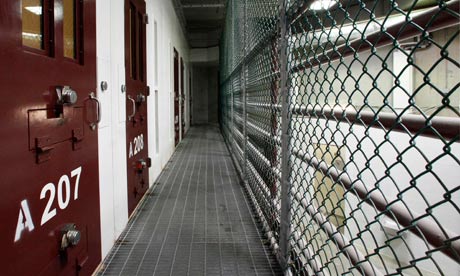Guantánamo hunger strikers make up half of inmate population, officials say
![]()
Eighty-four of the 166 remaining detainees are on hunger strike, a figure almost double the number previously released
Matt Williams in New York
guardian.co.uk
Guards moved Guantánamo prisoners into one-man cells in an attempt to end the strike. Photograph: Bob Strong/Reuters
More than half of the remaining detainees at Guantánamo Bay are now on a hunger strike, US military officials confirmed Sunday.
Of the 166 inmates at the controversial detention camp in Cuba, 84 are refusing all food as a protest against their indefinite confinement and conditions at the centre.
The figure is almost double the number previously released by officials, although inmates and their lawyers have long suggested that a majority of inmates were taking part.
Amongst those refusing food is Shaker Aamer, who has spent 11 years at Guantánamo. He remains behind bars despite being cleared for release six years ago.
He told the Observer – the Guardian’s sister paper – on Sunday that he had lost a quarter of his body weight since going on hunger strike more than 60 days ago.
“I barely notice all of my medical ailments any more – the back pain from the beatings I have taken, the rheumatism from the frigid air conditioning, the asthma exacerbated by the toxic sprays they use to abuse us. There is an endless list. And now 24/7, as the Americans say, I have the ache of hunger,” Aamer said.
He added: “I hope I do not die in this awful place. I want to hug my children and watch them as they grow. But if it is God’s will that I should die here, I want to die with dignity. I hope, if the worst comes to the worst, that my children will understand that I cared for the rights of those suffering around me almost as much as I care for them.”
Of the 84 prisoners on hunger strike, 16 are being force-fed. The military has said that none have life-threatening conditions, but a number of inmates and their lawyers have suggested that some men are close to death as a result of the action.
Last weekend, guards attempted to break hunger strikers’ resolve by forcibly removing them from communal areas and placing them in solitary cells. The move led to violent clashes, with guards firing “non-lethal” rounds on prisoners.
“The military responds with violence, as if that will break us; it draws us together,” Aamer told the Observer.
Related Articles
Saying No to the Apple Billions
![]()
The issues raised by the Apple deal with successive Irish governments go to the very core of the government’s attitude to citizens; to public services; to tax justice here and internationally; to fairness for our business sector; and to corporate social responsibility
Boston y Venezuela: el terrorismo de aquí y el de allí
![]()
James Petras Rebelion Traducido para Rebelión por Paco Muñoz de Bustillo Introducción Recientemente se han producido dos importantes ataques terroristas
Food scarcity: the timebomb setting nation against nation
![]()
A drying corn field in southern Minnesota. Bad weather has resulted in a poor harvest this year. Photograph: David I.




